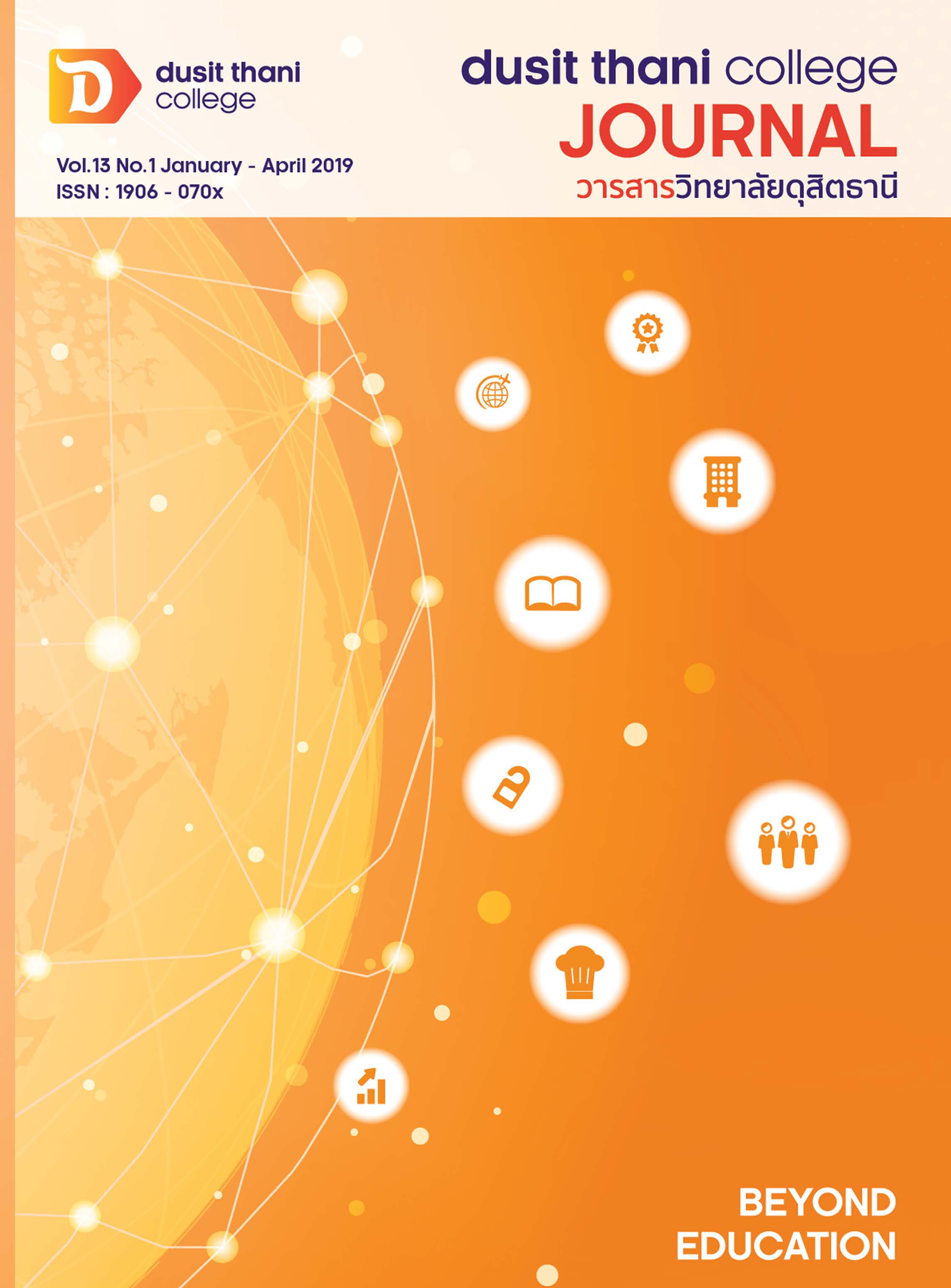การส่งเสริมอาหารไทย 4 ภาค ตามแนวคิดการตลาดเล่าเรื่อง
Main Article Content
บทคัดย่อ
ปฏิเสธไม่ได้เลยว่าอาหารไทยเป็นที่ยอมรับไปในระดับสากล ทั้งในด้านความมีชื่อเสียงและเป็นที่โปรดปรานของคนทั่วโลก การทำการตลาดแบบเล่าเรื่องกับอาหารไทยที่สะท้อนถึงนวัตวิถีนั้นเป็นอีกหนึ่งทางเลือกที่สามารถสร้างมูลค่าเพิ่มได้อย่างน่าสนใจ โดยเฉพาะอย่างยิ่งเอกลักษณ์ของอาหารไทยทั้ง 4 ภาคที่มีความแตกต่างกันแต่เป็นที่ชื่นชอบในการรับประทานและได้รับการยอมรับในเรื่องของเอกลักษณ์ด้านรสชาติและความหลากหลายของอาหาร ดังนั้นผู้ประกอบการสามารถนำแนวคิดดังกล่าวไปปรับใช้กับหลักการของ Menu Engineering ที่อาจจะใส่เรื่องราวความเป็นมาของอาหารแต่ละจานลงไปในตัวเมนูอาหารเพื่อเพิ่มมูลค่าในการให้บริการแก่ลูกค้าได้เช่นกัน บทความนี้จึงได้นำเสนอแนวคิดในการทำการตลาดแบบเล่าเรื่องจากอาหารทั้ง 4 ภาคโดยนำความโดดเด่นของจานอาหารมาสร้างเป็นเรื่องราว เพื่อเป็นแนวทางให้กับผู้ประกอบการร้านอาหารในการเพิ่มมูลค่าและสร้างเรื่องราวให้กับจานอาหารเพื่อสร้างความเป็นเอกลักษณ์ให้กับอาหารแต่ละจานได้อย่างน่าสนใจ
Article Details
นโยบายการพิจารณากลั่นกรองบทความ
- บทความวิจัยและบทความวิชาการทุกเรื่องที่จะได้รับการตีพิมพ์ต้องผ่านการพิจารณากลั่นกรองโดยผู้ทรงคุณวุฒิ (Peer Review) ในสาขาที่เกี่ยวข้อง จำนวน 3 ท่าน/บทความ
- บทความ ข้อความ ภาพประกอบและตารางประกอบที่ลงตีพิมพ์ในวารสารเป็นความคิดเห็นส่วนตัวของผู้เขียน กองบรรณาธิการไม่จำเป็นต้องเห็นด้วยเสมอไป และไม่มีส่วนรับผิดชอบใด ๆ ถือเป็นความรับผิดชอบของผู้เขียนแต่เพียงผู้เดียว
- บทความที่จะได้รับการตีพิมพ์จะต้องไม่เคยตีพิมพ์ เผยแพร่ที่ใดมาก่อน และไม่อยู่ระหว่างการพิจารณาของวารสารฉบับอื่น หากตรวจสอบพบว่ามีการตีพิมพ์ซ้ำซ้อน ถือเป็นความรับผิดชอบของผู้เขียนแต่เพียงผู้เดียว
- บทความใดที่ผู้อ่านเห็นว่าได้มีการลอกเลียนหรือแอบอ้างโดยปราศจากการอ้างอิง หรือทำให้เข้าใจผิดว่าเป็นผลงานของผู้เขียน กรุณาแจ้งให้กองบรรณาธิการวารสารทราบจะเป็นพระคุณยิ่ง
เอกสารอ้างอิง
Chiang Mai, Thailand.
2. Holliman, Geraint, & Rowley, Jennifer. (2014). Business to business digital content marketing: marketers’ perceptions of best practice. Journal of research in interactive marketing, 8(4), 269-293.
3. Jitnarin, Nattinee. (2011). Prevalence of overweight and obesity in Thai population: results of the National Thai Food Consumption Survey. Eating and Weight Disorders, 16(4), e242-e249.
4. Jones, Charlie, & Pimdee, Paitoon. (2017). Innovative ideas: Thailand 4.0 and the fourth industrial revolution. Asian International Journal of Social Sciences, 17(1), 4-35.
5. Koiso-Kanttila, Nina. (2004). Digital content marketing: a literature synthesis. Journal of Marketing Management, 20(1-2), 45-65.
6. Nanasombat, Suree, & Teckchuen. (2009). Antimicrobial, antioxidant and anticancer activities of Thai local vegetables. Journal of Medicinal Plants Research, 3(5), 443-449.
7. Panyaem, Kosin , Niemchai, Saranyaa, & Tawatnagu, Thaweedej (2018). Integrating of Menu Engineering and Electronic Word of Mouth Towards Restaurant Business. Dusit Thani College Journal, 12(Special), 405-418.
8. Piammongkol, Sumalika, Marks, Geoffrey , Williams, Gail, & Chongsuvivatwong, Virasakdi. (2004). Food and nutrient consumption patterns in third trimester Thai-Muslim pregnant women in rural southern Thailand. Asia Pacific journal of clinical nutrition, 13(3), 236-242.
9. Pongwiritthon, Ratthanan, Pakvipak, Pakphum, & Kantawongwan, Benyapa. (2016). Foreign Tourists’ Behaviors and Marketing Mix towards “Discover Thainess” for Tourism Development Guidelines in the Northern Region of Thailand. Journal of Community Development Research (Humanities and Social Sciences), 9(3), 127-139.
10. Pragattakomol, Ploycharas, & Taylor, Ken. (2018). The Evolution of Cultural Landscape and Built Environment Through Thai Food and Way of Living: The Case Study of Central Region of Thailand. Dusit Thani College Journal, 12(1), 124-149.
11. Printezis, Iryna, & Grebitus, Carola. (2018). Marketing Channels for Local Food. Ecological Economics, 152, 161-171.
12. Pruksorranan, Natthakan , Wisansing, Jutamas, & Vongvisitsin, Thanakarn (2017). Thainess and Local Wisdoms Integration through Food Supply Chain for Tourism Adding Value and Value Creation Approach. Journal of the faculty of Management Science, Lampang Rajabhat University, 10(2), 169-182.
13. Pulizzi, Joe. (2012). The rise of storytelling as the new marketing. Publishing research quarterly, 28(2), 116-123.
14. Puwastien, P, Raroengwichit, Monthip, Sungpuag, P, & Judprasong, K. (1999). Thai food composition tables. Salaya, Phutthamonthon: Institute of Nutrition, Mahidol University.
15. Roy, Hiran, Hall, C Michael, & Ballantine, Paul W. (2017). Trust in local food networks: The role of trust among tourism stakeholders and their impacts in purchasing decisions. Journal of Destination Marketing & Management, 6(4), 309-317.
16. Sharma, Amit, Moon, Joonho, & Strohbehn, Catherine. (2014). Restaurant's decision to purchase local foods: Influence of value chain activities. International Journal of Hospitality Management, 39, 130-143.
17. Sriboonruang, Komsun. (2014). Livelihood Strategies of Esan Farmers in Agri-food and Agro-fuel Business Context (in Thai). Walailak Journal of Social Sciences, 7(1), 51-93.
18. Yasmeen, Gisele. (2000). Not ‘From Scratch’: Thai food systems and ‘public eating’. Journal of Intercultural Studies, 21(3), 341-352.


